
Anthene lycaenina, the pointed ciliate blue, is a small butterfly found in India that belongs to the lycaenids or blues family found in Indomalayan realm. The species was first described by Cajetan Felder in 1868.
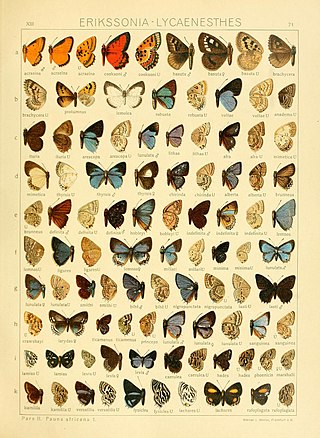
Anthene is a genus of butterflies in the family Lycaenidae, commonly called the ciliate blues or hairtails. The genus was erected by Edward Doubleday in 1847.

Iolaus is a genus of butterflies in the family Lycaenidae. The genera Argiolaus, Epamera, Iolaphilus and Stugeta are often included in Iolaus. Iolaus species are found in the Afrotropical realm.There are ca. 130 species in Iolaus

Anthene definita, the common ciliate blue or common hairtail, is a butterfly of the family Lycaenidae. It is found in southern Africa.

Anthene amarah, the black-striped hairtail, leaden hairtail or leaden ciliate blue, is a butterfly of the family Lycaenidae. It is found in tropical Africa and Arabia. The habitat consists of savanna and occasionally open areas in the forest zone.
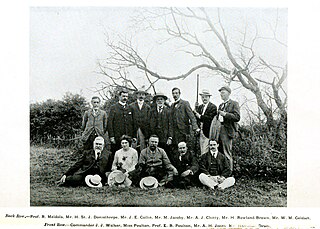
Hamilton Herbert Charles James Druce was an English entomologist who specialised in Lycaenidae and to a lesser extent Hesperiidae. He is not to be confused with his father, the English entomologist Herbert Druce (1846–1913) who also worked on Lepidoptera.

Iolaus neavei, or Neave's sapphire, is a butterfly in the family Lycaenidae. The species was first described by Hamilton Herbert Druce in 1910. It is found in Nigeria, Cameroon, the Republic of the Congo, the Democratic Republic of the Congo, Uganda and Tanzania. The habitat consists of forests.

Anthene crawshayi, Crawshay's hairtail or Crawshay's ciliate blue, is a butterfly in the family Lycaenidae. It is found in Senegal, the Gambia, Guinea-Bissau, Burkina Faso, Guinea, Sierra Leone, Ivory Coast, Ghana, Togo, Nigeria, Cameroon, Sudan, Uganda, Ethiopia, Somalia, Kenya, Tanzania, the Democratic Republic of the Congo, Malawi, Zambia, Zimbabwe and South Africa. The habitat consists of savanna and open forests.

Anthene ligures, the lesser indigo ciliate blue, is a butterfly in the family Lycaenidae. It is found in Ghana, Togo, Nigeria, Cameroon, Gabon, the Republic of the Congo, Angola, the Democratic Republic of the Congo, Uganda, western and central Kenya, Tanzania, Malawi and Zambia. The habitat consists of forests.

Anthene rubricinctus, the indigo ciliate blue, is a butterfly in the family Lycaenidae. It is found in Guinea, Sierra Leone, Liberia, Ivory Coast, Ghana, Togo, Nigeria, Cameroon, the Republic of the Congo, Gabon, Angola, the Democratic Republic of the Congo, Uganda, Kenya, Tanzania, Malawi and Zambia. The habitat consists of forest, especially stream banks.

Anthene scintillula, the golden ciliate blue, is a butterfly in the family Lycaenidae. It is found in Sierra Leone, Ivory Coast, Ghana, Nigeria, Cameroon, Equatorial Guinea, Gabon, the Republic of the Congo, the Central African Republic, the Democratic Republic of the Congo and Uganda. The habitat consists of forests.

Anthene sylvanus, the common indigo ciliate blue, is a butterfly in the family Lycaenidae. It is found in Senegal, Guinea-Bissau, Guinea, Sierra Leone, Burkina Faso, Liberia, Ivory Coast, Ghana, Togo, Benin, Nigeria, Cameroon, Gabon, the Republic of the Congo, the Central African Republic, the Democratic Republic of the Congo, Uganda and Tanzania. The habitat consists of forests and dense Guinea savanna.

Anthene versatilis, the versatile ciliate blue, is a butterfly in the family Lycaenidae. It is found in Nigeria, Cameroon, Gabon and the Democratic Republic of the Congo. The habitat consists of primary forests.

Anthene gemmifera, the jewelled ciliate blue, is a butterfly in the family Lycaenidae. It is found in Sierra Leone, Ghana, Cameroon, Ethiopia, Uganda, south-western Kenya and along the coast, Tanzania and Zambia. The habitat consists of the forest/savanna transition zone and deciduous woodland.

Anthene inconspicua, the inconspicuous ciliate blue, is a butterfly in the family Lycaenidae. The species was first described by Hamilton Herbert Druce in 1910. It is found in Ivory Coast, Ghana, eastern Nigeria, Cameroon, the Democratic Republic of the Congo, Uganda and north-western Tanzania. The habitat consists of forests.
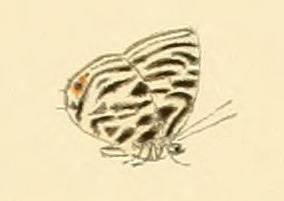
Anthene lamias, commonly known as the blotched ciliate blue, is a butterfly belonging to the family Lycaenidae. It is found in Guinea, Sierra Leone, Liberia, Ivory Coast, Ghana, Togo, Nigeria, Cameroon, Gabon, the Republic of the Congo, the Democratic Republic of the Congo, Uganda, Kenya and Tanzania. The habitat consists of primary forests, the forest/Guinea savanna transition zone and secondary forests.

Anthene obscura, the obscure ciliate blue, is a butterfly in the family Lycaenidae. The species was first described by Hamilton Herbert Druce in 1910. It is found in Ghana, Nigeria, Cameroon, Gabon and the Democratic Republic of the Congo. The habitat consists of forests.
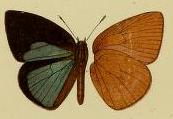
Stempfferia tumentia, the swollen epitola, is a butterfly in the family Lycaenidae. The species was first described by Hamilton Herbert Druce in 1910. It is found in Nigeria, Cameroon, the Republic of the Congo, the Central African Republic and the Democratic Republic of the Congo. The habitat consists of forests.
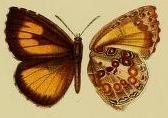
Lachnocnema luna, or Druce's large woolly legs, is a butterfly in the family Lycaenidae. The species was first described by Hamilton Herbert Druce in 1910. It is found in Ghana, eastern Nigeria, Cameroon, Gabon, the Republic of the Congo, the north-eastern part of the Democratic Republic of the Congo, Uganda and north-western Tanzania. The habitat consists of forests.

Tetrarhanis nubifera, the white on-off, is a butterfly in the family Lycaenidae. The species was first described by Hamilton Herbert Druce in 1910. It is found in Cameroon, the Republic of the Congo and possibly south-eastern Nigeria. The habitat consists of primary forests.











